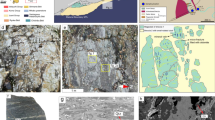Abstract
The Neogene sediments can be characterized by intensive geomechanical heterogeneity. Depending on their grain size distribution and on their cementation degree, they behave from medium strength rock formations to soft rock–hard soil formation. This heterogeneity influences the variety of the failure mechanisms and the intensity of the occurring phenomena. The detailed description of the complex failure mechanism occurred in a slope consisting of both Neogene phases in Limenaria-Thasos, and the detection of the preparatory and the triggering causal factor provide substantial data for the confrontation of similar failures. Also, the analytical presentation of the procedure and the conclusions coming from the conducted back analysis, conducted by means of the classical graphical method of decomposing forces on the stereo-net, constitutes an ideal example application for the simulation of corresponding composite wedge failures.







Similar content being viewed by others
Abbreviations
- Ten:
-
Tension crack
- F.P:
-
Failure plane
- S.F:
-
Slope face
- U.F:
-
Upper slope face
References
Hocking G (1976) A method of distinguishing between single and double plane sliding of tetrahedral wedges. Int J Rock Mech Min Sci 13:225–226
Hoek E, Bray JW (1981) Rock slope engineering, revised 3rd edition. Institution of Mining and Metallurgy, London, pp 341–351
Hoek E, Kaiser PK, Bawden WF (1995) Support of underground excavations in hard rock. A.A.Balkema, Rotterdam, Brookfield
Koukis G, Sabatakakis N, Nikolaou N, Loupasakis C (2005) Landslide hazard zonation in Greece. In: Sassa K, Fukuoka H, Wang F, Wang G (eds), Proceedings of open symposium on landslide risk analysis and sustainable disaster management in the First General Assembly of International Consortium on Landslides. Springer, Berlin, pp 291–296
Kumsar H, Aydan Ö, Ulusay R (2000) Dynamic and static stability assessment of rock slopes against wedge failures. Rock Mech Rock Eng 33:31–51
Priest S (1993) Discontinuity analysis for rock engineering. Chapman and Hall, London
Varnes DJ (1978) Slope movement types and processes. In: Schuster RL, Krizek RJ (eds), Landslides: analysis and control, Special Report 176. Transportation Research Board, National Academy of Sciences, Washington, pp 11–33
WP/WLI (International Geotechnical Societies’ UNESCO Working Party on World Landslide Inventory) (1993) A suggested method for describing the activity of a landslide. Bull Int Assoc Eng Geol 47:53–57
WP/WLI (International Geotechnical Societies’ UNESCO Working Party on World Landslide Inventory) (1994) A suggested method for reporting landslides causes. Bull Int Assoc Eng Geol 50:71–74
WP/WLI (International Geotechnical Societies’ UNESCO Working Party on World Landslide Inventory) (1995) A suggested method for describing the rate of movement of a landslide. Bull Int Assoc Eng Geol 52:75–78
Author information
Authors and Affiliations
Corresponding author
Rights and permissions
About this article
Cite this article
Loupasakis, C., Konstantopoulou, G. A failure mechanism of the fine Neogene formations: an example from Thasos, Greece. Landslides 4, 351–355 (2007). https://doi.org/10.1007/s10346-007-0091-2
Received:
Accepted:
Published:
Issue Date:
DOI: https://doi.org/10.1007/s10346-007-0091-2




